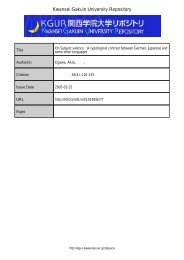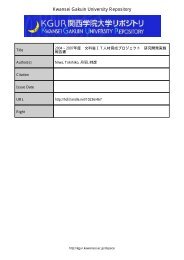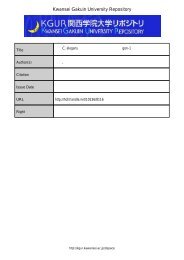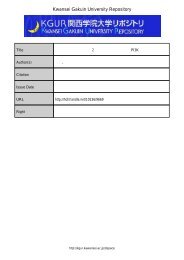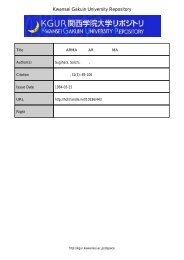Kwansei Gakuin University Repository
Kwansei Gakuin University Repository
Kwansei Gakuin University Repository
Create successful ePaper yourself
Turn your PDF publications into a flip-book with our unique Google optimized e-Paper software.
which is required to achieve economic efficiency in industries.<br />
Much attention has been paid to the post-entry performance of new firms as<br />
a way to assess the competitive process in markets. The survival and exit of new<br />
firms have been addressed in a rich stream of literature. To date, a large number<br />
of empirical studies have examined the survival and exit of firms during the start-<br />
up period. Audretsch (1991), for example, estimated the determinants of 10-year<br />
survival rates for new establishments, using a logit model. Wagner (1994) also<br />
examined the survival of new firms and the duration of survival in years, using<br />
a probit model and a tobit model, respectively. Audretsch and Mahmood (1991,<br />
1995) applied a proportional hazards model proposed by Cox (1972) (PH model,<br />
henceforth) to analyze the survival and exit of new establishments and firms. The<br />
PH model has several advantages over binary choice models such as the logit and<br />
probit models, because the PH model takes into account the duration of firm survival<br />
and censoring of observations. Given that post-entry performance depends on firms’<br />
life cycles, the PH model based on firms’ age is more suitable. By using the PH<br />
model, we can utilize not only information on whether the firm exits but also the<br />
time at which the firm exits. Mata and Portugal (1994) and Mata et al. (1995) used<br />
the PH model to estimate the determinants of survival of new firms and plants in<br />
Portugal. Honjo (2000a) also investigated the determinants of business failure of<br />
new firms in Japan, excluding other forms of exit. 2<br />
Although it is worthwhile to understand what factors have more influence on<br />
the survival and exit of new firms, the previous studies tend to treat all forms of<br />
exit as homogeneous. As Parker (2009) pointed out, entrepreneurs close businesses<br />
for a variety of reasons, and there are economic differences between forms of exit.<br />
Ignoring heterogeneity between the forms of exit may yield incorrect interpretations<br />
of the factors leading to the survival and exit of firms. Nevertheless, research that<br />
2 For Japan, Doi (1999) examined the determinants of firm exit at the industry level. Harada<br />
(2007) also examined the determinants of small-firm exit in Japan, by distinguishing between<br />
economic-forced exit and non-economic-forced exit.<br />
4



